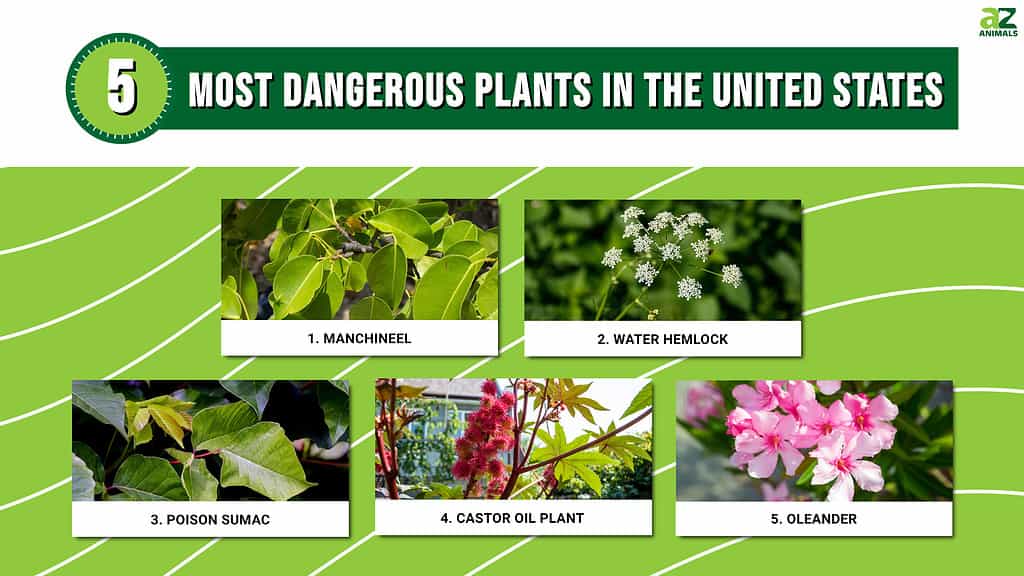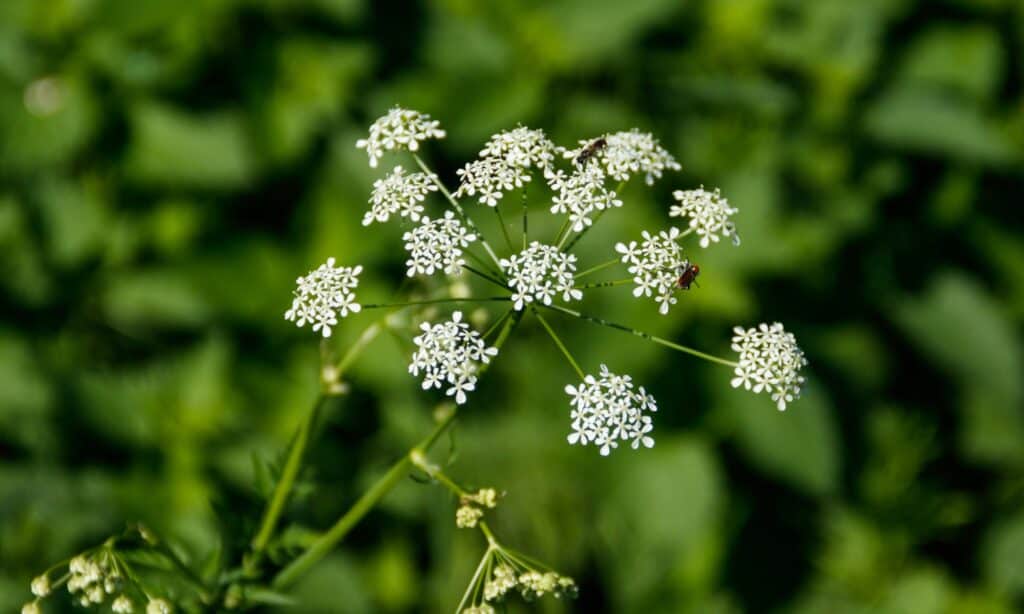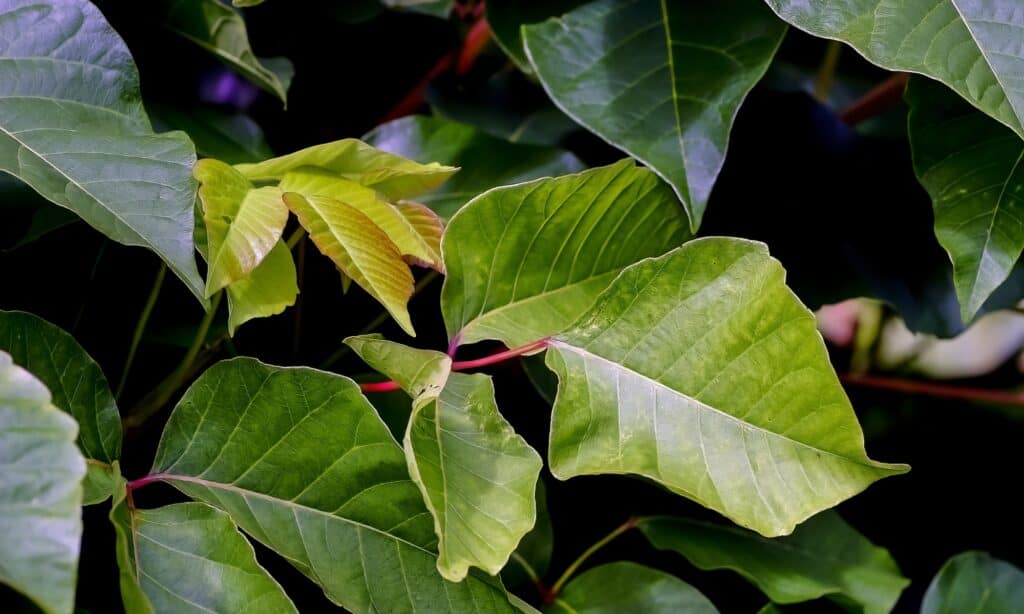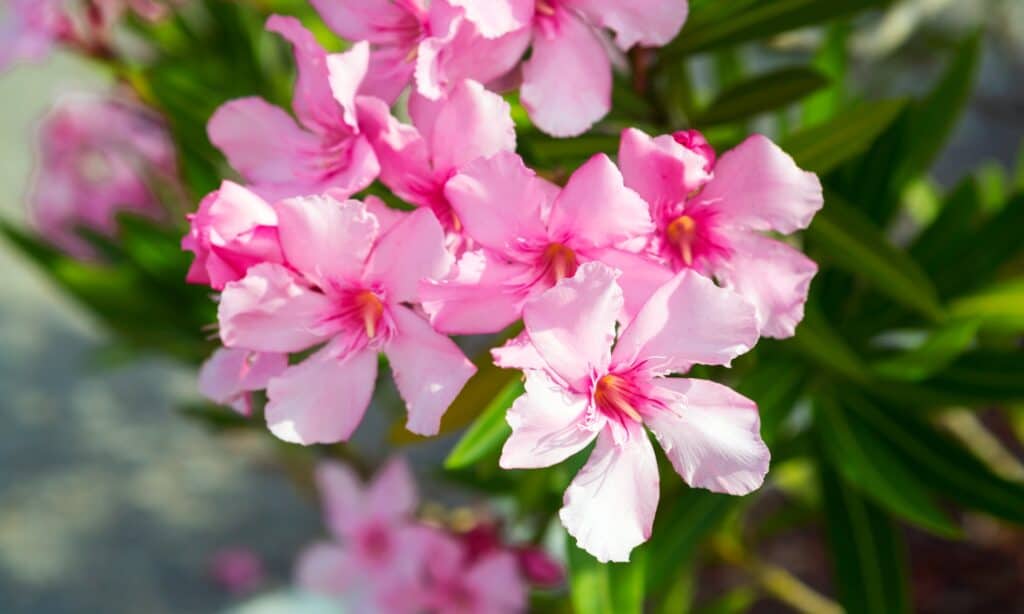
Plants are an important part of the natural ecosystem. They serve as food, purify the air and beautify the landscape. However, not all plants in the fields and gardens are innocent and harmless. In fact, some of the most beautiful plants have a sinister side. Plants contain chemical constituents, most of which are safe to ingest. However, a few plants contain potentially harmful chemicals that can make you sick or even kill you if you eat them. If you spend a lot of time outdoors, it is vital that you’re familiar with this plant so you’ll know how to avoid them. Here are a few of the most dangerous plants in the United States.
1. Manchineel (Hippomane mancinella)

All parts of the Manchineel contain powerful toxins.
©iStock.com/shakzu
The Manchineel has been aptly nicknamed the manzanilla de la Muerte. The Spanish name translates as the “little apple of death.” On first look, it’s easy to mistake the Manchineel for an actual apple. To further add to the deception, the fruit is sweet and tasty. But that’s where its similarity with the apple ends. The Manchineel is one of the most dangerous trees in the world and one of the most dangerous plants in the United States.
And it’s not just the fruit of this plant that’s dangerous. All parts of this tree contain powerful toxins. The toxins it contains will burn the mouth and throat of anyone unfortunate enough to eat the fruit. Also, your throat will begin to swell in just a few minutes. The effects are even more dangerous if you infest the fruit. It causes internal bleeding, diarrhea, and edema.
Interestingly, that’s just getting started on the toxicity of this plant which is native to Florida and the Caribbean islands. Manchineel is so dangerous that you don’t even need to go as far as eating it before you feel the toxicity. If the tree sap gets washed down on your body while standing underneath the tree branches, it can cause severe skin blisters. Burning the trees is just as dangerous. The smoke that emanates is toxic and can cause respiratory complications and blindness.
2. Water Hemlock (Cicuta douglasii)

Water hemlocks have one of the most dangerous neurotoxins in the world.
©iStock.com/OlyaSolodenko
According to the USDA, the water hemlock is ‘the most violently toxic plant that grows in North America. All parts of the plant contain a dangerous neurotoxin called cicutoxin. This plant grows in moist habitats like marshes and meadows but may also occur in unsuspecting locations like roadsides.
Cicutoxin, the poisonous compound in this plant, is one of the most dangerous neurotoxins in the world. Although the toxin can be found in all parts of the plant, it is particularly concentrated in the root tubers. Consuming a small piece of this tuber can kill a 1200-pound animal. The seeds of this plant are poisonous as well. If ingested, death can occur within a few hours. This typically follows painful and violent complications like seizures, brain swelling, kidney failure, etc.
3. Poison Sumac (Toxicodendron vernix)

Poison sumacs are dangerous plants in the United States.
©iStock.com/Werner Meidinger
Ever heard the saying: “Leaves of three, let them be?” That adage is a famous reference to plants in the Toxicodendron genus. The plant typically has a single large center leaf and two smaller side ones. Members of this genus, like poison ivy and poison oak, are among the most dangerous plants in the United States.
However, the poison sumac is arguably the most dangerous member of this group. The chemical in this plant causes severe rashes with a painful burning sensation, swelling, and itching.
What makes the plant even more dangerous is that it doesn’t have to come in direct contact with the skin. Even touching a piece of clothing that had been in contact with this resin can be dangerous. Smoke from burning plants can cause serious problems if you inhale it or it gets on your skin.
4. Castor Oil Plant (Ricinus communis)

Without being processed, castor oil plant can cause severe symptoms,
©iStock.com/NATALIA NOSOVA
The castor oil plant is considered very useful for various purposes. In fact, the plant is not native to the United States but is now widely planted here and in other parts of the world due to its usefulness. Oil extracted from the castor oil plant is useful for manufacturing soaps, perfumes, and inks. It is also used in preparing laxatives and other medicines. Ironically, the plant is only useful when processed as it is naturally one of the most dangerous plants out there.
The seeds of this plant contain a chemical known as ricin – one of the most toxic plant chemicals. Eating just a single bean can cause severe symptoms, and ingesting up to four seeds can be fatal. Victims often suffer gastroenteritis with symptoms like vomiting and diarrhea.
5. Oleander (Nerium oleander)

Despite their dangerous nature, oleanders are still used as ornamental plants.
©iStock.com/Katrin_Timoff
This is one plant you probably wouldn’t expect on the list of the most dangerous plants because of how common it is. The oleander plant is one of the most common garden plants in the country. Yet, this plant is so dangerous that having it so close to the house is a risky thing to do.
All parts of the oleander plant are potentially toxic. You don’t want your pet or children to ingest any part of the oleander plant. It can cause serious stomach pain, headache, diarrhea, and vomiting. Even a small amount of this plant can cause adverse effects.
So why is such a dangerous plant still one of the most popular ornamental plants around? It’s simply because it’s so hardy and easy to grow. It grows rapidly and has a beautiful appearance. People often favor low-maintenance plants like this for their gardens, but you must take precautions to avoid exposing unsuspecting people to danger.
In addition to these plants, some other notable mentions include rosary pea, monkshood, belladonna, and white snakeroot. These are some of the most dangerous plants in the United States. While they’re still widely planted due to their potential benefits, you should avoid ingesting or direct contact with these plants for your safety.
Summary of the Most Dangerous Plants in the United States
Here is a summary of the most dangerous plants in the U.S. Ingestion of these plants can cause death to humans and pets- so please exercise caution if you come across them.
| # | Plant | Danger |
|---|---|---|
| 1 | Manchineel | Every part of this tree is extremely toxic – even the sap blisters the skin |
| 2 | Water Hemlock | Cicutoxin, the poisonous compound in this plant, is one of the most dangerous neurotoxins in the world |
| 3 | Poison Sumac | The chemical in this plant causes severe rashes with a painful burning sensation, swelling, and itching |
| 4 | Castor Oil Plant | The seeds of this plant contain a chemical known as ricin – one of the most toxic plant chemicals |
| 5 | Oleander | All parts are toxic |
The photo featured at the top of this post is © iStock.com/NATALIA NOSOVA
Sources
- MedicalNewsToday (1970) medicalnewstoday.com/articles/poisonous-plants#manchineel
Thank you for reading! Have some feedback for us? Contact the AZ Animals editorial team.






